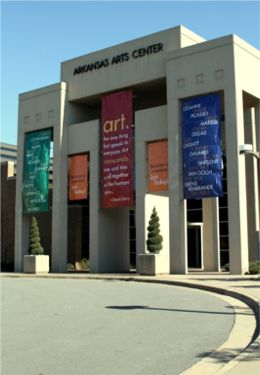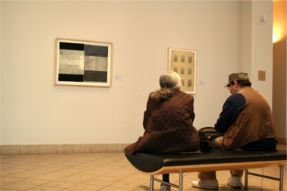Difference between revisions of "Arkansas Arts Center"
(→External links) |
|||
| (15 intermediate revisions by 2 users not shown) | |||
| Line 1: | Line 1: | ||
| − | The '''Arkansas Arts Center''' is a museum of arts and a center for the performing arts south of downtown Little Rock, located at 501 E. 9th Street. The museum has pieces from little-known locals artists as well as prominent artists such as Paul Cézanne, Edgar Degas, Albrecht Dürer, Roy Lichtenstein, Georgia | + | [[Image:Art Center.1.jpg|thumb|300px|Facade of the Center. Photo by Casey Gambill.]] |
| + | [[Image:Art Center.2.jpg|thumb|300px|Signac Gallery Entrance. Photo by Casey Gambill.]] | ||
| + | [[Image:Art Visitor.jpg|thumb|300px|Visitors admire art in the building's atrium. Photo by Casey Gambill.]] | ||
| + | The '''Arkansas Arts Center''' (AAC) is a museum of arts and a center for the performing arts south of downtown Little Rock, located at 501 E. 9th Street in historic [[MacArthur Park]]. The museum has pieces from little-known locals artists as well as prominent artists such as Paul Cézanne, Edgar Degas, Albrecht Dürer, Roy Lichtenstein, Georgia O'Keeffe, Claude Monet, Pablo Picasso, Odilon Redon, Rembrandt, Diego Rivera, Jackson Pollock, Allison Saar, Peter Paul Rubens, Vincent van Gogh, and Andrew Wyeth. Contemporary works by [[Dale Chihuly]], Albert Paley, Peter Voulkos, and Dorothy Gill Barnes, are also on display. | ||
| − | The collection also features handcrafts, photographs, drawings, sculptures, woodcuts, ceramics, collages, and works of other mediums. Arkansas artists and themes are highlighted, such as photographs that detail the [[ | + | The collection also features handcrafts, photographs, drawings, sculptures, woodcuts, ceramics, collages, and works of other mediums. Arkansas artists and themes are highlighted, such as photographs that detail the Little Rock [[Central High School]] [[desegregation crisis]] in 1957. |
| − | The center is perhaps most famous for The [[James T. Dyke Collection]], a large compilation of pieces from French artist [[Paul Signac]]. The collection was made available through a generous donation that left 133 Signac pieces to the museum. Although many of the works are often on loan at other art venues, Little Rock visitors can still view pieces that span the artist’s 50+ year career. | + | The center is perhaps most famous for The [[James T. Dyke Collection]], a large compilation of pieces from French post-impressionist artist [[Paul Signac]]. The collection was made available through a generous donation that left 133 Signac pieces to the museum. Although many of the works are often on loan at other art venues, Little Rock visitors can still view pieces that span the artist’s 50+ year career. |
| − | Each year the museum hosts a number of shows such as the annual [[Delta Exhibition]], a competition open to Arkansans and the members of all of 6 surrounding states. The museum also boasts a library, gift store, the [[Best Impressions]] restaurant, community gallery, a [[children’s theater]], and a museum school. The school offers seminars on art appreciation, ceramics, drawing, photography, theater, woodworking, and jewelry making. | + | Each year the museum hosts a number of shows such as the annual [[Delta Exhibition]], a competition open to Arkansans and the members of all of 6 surrounding states. The museum also boasts a library, gift store, the [[Best Impressions]] restaurant, community gallery, a [[children’s theater]], and a museum school. The school offers seminars on art appreciation, ceramics, drawing, photography, theater, woodworking, and jewelry making. 80 employees help the center and the various programs run smoothly. |
According to Executive Director Dr. [[Ellen "Nan" Plummer]], the museum had 450,000 visitors during 2007. The curator of the Arkansas Art Center is [[Anne Gochenour]]. | According to Executive Director Dr. [[Ellen "Nan" Plummer]], the museum had 450,000 visitors during 2007. The curator of the Arkansas Art Center is [[Anne Gochenour]]. | ||
The museum is free of charge. The center's phone number is 501-372-4000. | The museum is free of charge. The center's phone number is 501-372-4000. | ||
| + | |||
| + | ====History of the Arkansas Arts Center==== | ||
| + | |||
| + | The Arkansas Arts Center was founded as the Museum of Fine Arts in 1937. The façade of the original building, constructed with Works Progress Administration funds, is still visible as an interior wall of the contemporary center. In 1963 the museum reopened as the AAC after a $1.5 million dollar renovation and extension of facilities. To recognize the substantial monetary and in-kind contributions of its leading donor, [[Winthrop Rockefeller]], the [[Winthrop Rockefeller Gallery]] opened in 1982. | ||
==References== | ==References== | ||
| + | |||
| + | *John L. Ward, ''Winthrop Rockefeller, Philanthropist: A Life of Change'' (Fayetteville: University of Arkansas Press, 2004), 47. | ||
==External links== | ==External links== | ||
*[http://www.arkarts.com/pdfs/Artist_list.pdf A complete list of all artists on exhibit at the Arkansas Arts Center] | *[http://www.arkarts.com/pdfs/Artist_list.pdf A complete list of all artists on exhibit at the Arkansas Arts Center] | ||
| + | [[Category:Art]] | ||
[[Category:Museums]] | [[Category:Museums]] | ||
| − | |||
Latest revision as of 09:48, 21 February 2010
The Arkansas Arts Center (AAC) is a museum of arts and a center for the performing arts south of downtown Little Rock, located at 501 E. 9th Street in historic MacArthur Park. The museum has pieces from little-known locals artists as well as prominent artists such as Paul Cézanne, Edgar Degas, Albrecht Dürer, Roy Lichtenstein, Georgia O'Keeffe, Claude Monet, Pablo Picasso, Odilon Redon, Rembrandt, Diego Rivera, Jackson Pollock, Allison Saar, Peter Paul Rubens, Vincent van Gogh, and Andrew Wyeth. Contemporary works by Dale Chihuly, Albert Paley, Peter Voulkos, and Dorothy Gill Barnes, are also on display.
The collection also features handcrafts, photographs, drawings, sculptures, woodcuts, ceramics, collages, and works of other mediums. Arkansas artists and themes are highlighted, such as photographs that detail the Little Rock Central High School desegregation crisis in 1957.
The center is perhaps most famous for The James T. Dyke Collection, a large compilation of pieces from French post-impressionist artist Paul Signac. The collection was made available through a generous donation that left 133 Signac pieces to the museum. Although many of the works are often on loan at other art venues, Little Rock visitors can still view pieces that span the artist’s 50+ year career.
Each year the museum hosts a number of shows such as the annual Delta Exhibition, a competition open to Arkansans and the members of all of 6 surrounding states. The museum also boasts a library, gift store, the Best Impressions restaurant, community gallery, a children’s theater, and a museum school. The school offers seminars on art appreciation, ceramics, drawing, photography, theater, woodworking, and jewelry making. 80 employees help the center and the various programs run smoothly.
According to Executive Director Dr. Ellen "Nan" Plummer, the museum had 450,000 visitors during 2007. The curator of the Arkansas Art Center is Anne Gochenour.
The museum is free of charge. The center's phone number is 501-372-4000.
History of the Arkansas Arts Center
The Arkansas Arts Center was founded as the Museum of Fine Arts in 1937. The façade of the original building, constructed with Works Progress Administration funds, is still visible as an interior wall of the contemporary center. In 1963 the museum reopened as the AAC after a $1.5 million dollar renovation and extension of facilities. To recognize the substantial monetary and in-kind contributions of its leading donor, Winthrop Rockefeller, the Winthrop Rockefeller Gallery opened in 1982.
References
- John L. Ward, Winthrop Rockefeller, Philanthropist: A Life of Change (Fayetteville: University of Arkansas Press, 2004), 47.


